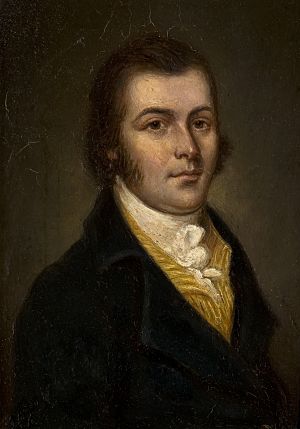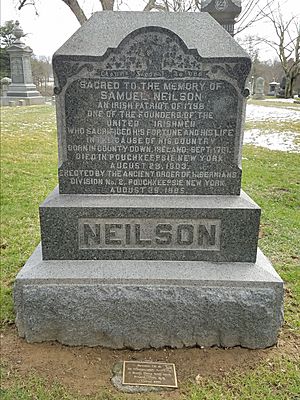Samuel Neilson facts for kids
Quick facts for kids
Samuel Neilson
|
|
|---|---|
 |
|
| Born | 17 September 1761 Ballyroney, County Down, Ireland
|
| Died | 29 August 1803 (aged 41) |
| Resting place | Poughkeepsie Rural Cemetery |
| Nationality | Irish |
| Occupation | Newspaperman |
|
Notable work
|
Northern Star |
| Movement | Society of United Irishmen |
| Criminal charge(s) | High treason |
| Criminal penalty | Exile |
Samuel Neilson (born September 17, 1761 – died August 29, 1803) was an important Irish businessman, journalist, and political figure. He helped start a group called the Society of United Irishmen. He also created their newspaper, the Northern Star. Like many other Protestants in Belfast, he was inspired by the French Revolution. This made him want big changes in Ireland.
In 1797, he was arrested, and the Northern Star newspaper was shut down. He was in prison during the rebellion of 1798. So, he could not take part in it. Later, he was sent away to the United States. He died there from a serious illness called yellow fever.
Contents
Early Life and Business
Samuel Neilson was born in Ballyroney, County Down, in the north of Ireland. His father, Alexander, was a Presbyterian minister. This meant Samuel grew up in a religious household. He was the second of eight sons and five daughters.
He went to school in his local area. Like many people at the time, he was influenced by new ideas. These ideas came from English and Scottish thinkers. At 16, Samuel became an apprentice to his older brother, John. They worked in the business of selling woollen cloth in Belfast. When he was 24, Samuel started his own business in the town.
Joining the United Irishmen
Even though his business was doing well, Samuel Neilson became very interested in politics. He had been part of an earlier group called the Volunteer movement. This group wanted to make changes in Ireland. In 1790, he helped Robert Stewart get elected to the Irish Parliament.
In 1791, the French Revolution inspired him. He suggested to Henry Joy McCracken that they should create a political group. This group would include Irish people of all religions. He helped start the United Irishmen in Belfast. At first, it was a secret society. He also helped set up the Dublin United Irishmen, which was a more open political club. His strong support for the French Revolution led his friend Wolfe Tone to call him "the Jacobin". This name meant he was very radical.
In 1792, he started the newspaper for the United Irishmen, called the Northern Star. Starting this newspaper used up all his money. As the editor, he was a clear target for the authorities. He faced legal trouble many times and was put in jail twice between 1796 and 1798. When Britain and France went to war in 1793, the United Irishmen became involved. They wanted to help Ireland become free from British control. Samuel Neilson worked hard in Ireland to organize groups of Irishmen. He helped them prepare to fight for independence from Britain.
Planning for Change
Samuel Neilson was one of several "state prisoners." These were people held in jail without being formally charged. He was released in February 1798 because friends asked for his release. He was not well at the time. After his release, he immediately joined the United Irishmen again. He sided with the leaders who wanted to start a rebellion right away. Others wanted to wait for help from France.
However, the United Irishmen had spies among them. These spies shared their plans with the government in Dublin Castle. In March 1798, a spy shared information about a meeting. This led to the arrest of most of the leaders. Only Neilson and Lord Edward Fitzgerald were still free and important. Neilson and Fitzgerald decided to move forward with their plans. They would use their own resources, not waiting for France.
Arrested Again
The date for the rebellion was set for May 23. As it got closer, the authorities worked hard to arrest the remaining leaders. On May 18, Lord Edward Fitzgerald was found in his hiding place. He was hurt while trying not to be caught. Neilson now had the job of finishing the plans for the rebellion. He decided that Fitzgerald was too important to lose. He tried to rescue him from Newgate Prison in Dublin.
Neilson did not want to share his plans too early, fearing another betrayal. He went to check out the prison. But one of his former jailers saw him. After a struggle, Neilson was caught and taken into the prison.
Prison and Life in Exile
Samuel Neilson was accused of a very serious crime against the government. He was held in Kilmainham Jail with other prisoners. He stayed there during the rebellion that did not succeed. After some leaders were executed, Neilson and the remaining prisoners made a deal. They agreed to share details about the United Irishmen group and their plans. In return, they would be sent out of the country.
After the rebellion was put down, he was moved to Fort George in Inverness-shire, Scotland. In 1802, he was sent to the Netherlands. From there, he traveled to America. He arrived in December 1802. Neilson was planning to restart the Northern Star newspaper. He also wanted to bring his family over from Ireland. But a serious illness called yellow fever spread in the city in August 1803. He became sick while traveling up the Hudson River. He landed at Poughkeepsie on Sunday, August 28. He died the next morning.


